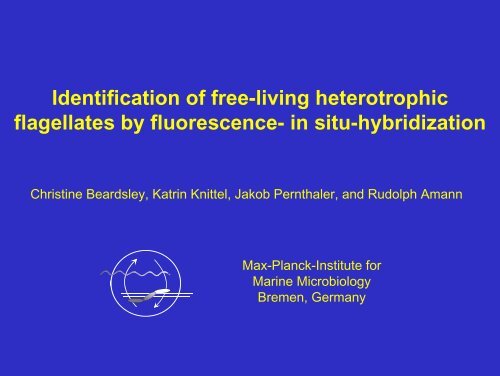Identification of free-living heterotrophic flagellates by fluorescence ...
Identification of free-living heterotrophic flagellates by fluorescence ...
Identification of free-living heterotrophic flagellates by fluorescence ...
Create successful ePaper yourself
Turn your PDF publications into a flip-book with our unique Google optimized e-Paper software.
<strong>Identification</strong> <strong>of</strong> <strong>free</strong>-<strong>living</strong> <strong>heterotrophic</strong><br />
<strong>flagellates</strong> <strong>by</strong> <strong>fluorescence</strong>- in situ-hybridization<br />
Christine Beardsley, Katrin Knittel, Jakob Pernthaler, and Rudolph Amann<br />
Max-Planck-Institute for<br />
Marine Microbiology<br />
Bremen, Germany
Common methods<br />
• light microscopy<br />
• electron microscopy<br />
• epi<strong>fluorescence</strong> m.<br />
live counts<br />
species identification<br />
bulk measurements
Common methods<br />
• light microscopy<br />
• electron microscopy<br />
• epi<strong>fluorescence</strong> m.<br />
live counts<br />
species identification<br />
bulk measurements<br />
New method<br />
• FISH<br />
quantitative phylogenetic<br />
analysis
FISH in <strong>flagellates</strong><br />
• sensitivity:<br />
! fluorescent dyes<br />
! HRP-labeled probes with TSA<br />
• aut<strong>of</strong>luorescence <strong>of</strong> chlorophyll
0.1<br />
Different trophic modes in closely related species<br />
Paraphysomonas foraminifera<br />
Paraphysomonas sp.<br />
Paraphysomonas foraminifera<br />
Paraphysomonas imperforata<br />
Paraphysomonas imperforata<br />
Metanophrys similis<br />
Paraphysomonas bandaiensis<br />
Paraphysomonas butcheri<br />
Tessellaria volvocina<br />
Mallomonas akrokomos<br />
Mallomonas annulata<br />
Mallomonas adamas<br />
Mallomonas splendens<br />
Mallomonas striata<br />
Mallomonas striata<br />
Mallomonas papillosa<br />
Mallomonas rasilis<br />
Mallomonas caudata<br />
Mallomonas matvienkoae<br />
Synura mammillosa<br />
Synura spinosa<br />
Synura sphagnicola<br />
Synura uvella<br />
Synura glabra<br />
Synura petersenii<br />
uncultured eukaryote, AY046836<br />
uncultured eukaryote, AY046860<br />
uncultured eukaryote, AY046844<br />
uncultured eukaryote, AY046852<br />
uncultured eukaryote, AY046864<br />
Heterosigma akashiwo<br />
Heterosigma akashiwo<br />
Heterosigma carterae<br />
Chattonella subsalsa<br />
Vacuolaria virescens<br />
Pteridomonas danica<br />
Apedinella radians<br />
Pseudopedinella elastica<br />
Ciliophrys infusionum<br />
Rhizochromulina cf. marina<br />
eukaryote clone OLI11025<br />
Dictyocha speculum<br />
Hyphochytrium catenoides<br />
Developayella elegans<br />
Oomycete<br />
<strong>heterotrophic</strong><br />
autotrophic<br />
<strong>heterotrophic</strong><br />
autotrophic
FISH in <strong>flagellates</strong><br />
• sensitivity:<br />
! fluorescent dyes<br />
! HRP-labeled probes with TSA<br />
• aut<strong>of</strong>luorescence <strong>of</strong> chlorophyll<br />
! UV-excitable fluorochrome Alexa-350
Hybridization with HRP-labeled probes:<br />
HRP-probes<br />
+<br />
flagellate cell<br />
ribosomes<br />
Incubation with Alexa350-labeled tyramides:
Mixed culture <strong>of</strong> Ochromonas sp. and<br />
Paraphysomonas imperforata<br />
a<br />
b<br />
a<br />
c<br />
b<br />
d<br />
10 µm<br />
10 µm<br />
Hybridization signal with EUK516<br />
Chlorophyll aut<strong>of</strong>luorescence<br />
a+b: Ochromonas sp. (mixotrophic)<br />
c+d: Paraphysomonas imperforata (<strong>heterotrophic</strong>)
Development <strong>of</strong> group specific probes<br />
Pteridomonas danica<br />
Apedinella radians<br />
Pseudopedinella elastica<br />
Ciliophrys infusionum<br />
Rhizochromulina cf. marina<br />
eukaryote clone OLI11025<br />
Dictyocha speculum<br />
Oomycete<br />
Pedinellales /<br />
Rhizochromulinales<br />
0.1
Probe design:<br />
PEDI1646 (5'-TTA CCT TCG ATC GGT AGG-3’)<br />
mismatches<br />
target sequence<br />
PEDI1646<br />
---CCUACCGAUCGAAGGUAA---<br />
Apedinella radians 0 ---CCUACCGAUCGAAGGUAA---<br />
Pteridomonas danica 0 ---CCUACCGAUCGAAGGUAA---<br />
Pseudopedinella elastica 0 ---CCUACCGAUCGAAGGUAA---<br />
Ciliophrys infusionum 0 ---CCUACCGAUCGAAGGUAA---<br />
Rhizochromulina cf marina 0 ---CCUACCGAUCGAAGGUAA---<br />
Eukaryote clone OLI11025 2 ---CCUACCGAUCGUAGGUGA---<br />
Willaertia magna 3 ---CCUACCGAUGGAAUGgAA---<br />
Plasmodium vivax 3 ---CCUACCGAUCGAAAGAUA---<br />
Dictyocha speculum 5 ---CCUACCGAUUGAAUGGCU---
Mixed culture <strong>of</strong> Pteridomonas danica and<br />
Dictyocha speculum<br />
Hybridization<br />
signal with<br />
PEDI1646<br />
a<br />
c<br />
a<br />
a<br />
c<br />
b<br />
b<br />
d<br />
ut<strong>of</strong>luorescence<br />
<strong>of</strong> chlorophyll<br />
d<br />
b<br />
10 µm<br />
a+b: Pteridomonas danica (<strong>heterotrophic</strong>)<br />
c+d: Dictyocha speculum (autotrophic)
Conclusion<br />
FISH<br />
Phylogeny
Conclusion<br />
FISH<br />
+<br />
HRP<br />
Phylogeny<br />
Sensitivity
Conclusion<br />
FISH<br />
+ HRP +<br />
UV-dye<br />
Phylogeny<br />
Sensitivity<br />
Trophic mode
Conclusion<br />
FISH<br />
+ HRP +<br />
UV-dye<br />
Phylogeny<br />
Sensitivity<br />
Trophic mode<br />
Rapid analysis <strong>of</strong> structure and function<br />
<strong>of</strong> environmental flagellate communities
















